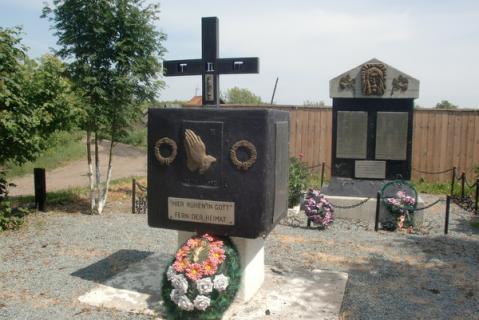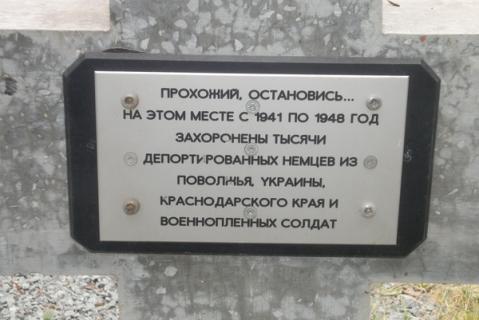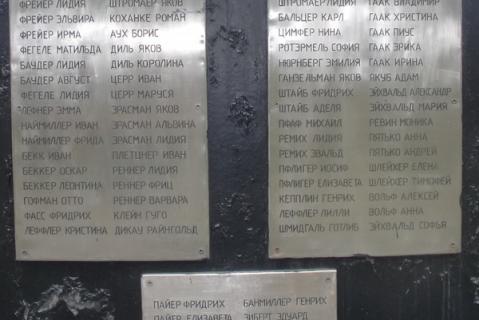The Victims of War complex is located in the former German cemetery on the outskirts of Yurga.
Soviet Germans deported in 1941 from the Volga Republic, the Krasnodar Region and Ukraine were buried here, as were former Soviet citizens repatriated from Germany in 1945 and 1946, as well as POWs who died between 1944 and 1947 in camp No 526. The number buried here is unknown and there are no lists of their names. Josif Tserr from Hannover drew on the recollections of eyewitnesses to compile a list of 213 German forced settlers who died and were buried there. The cemetery was destroyed in the 1960s and later used for garden allotments.
The first monument to German forced labourers was opened on 27 August 2000 on a plot of 0.6 hectares purchased by the Vozrozhdenie Society of Yurga Germans and the association of former Yurga dwellers (chairman Josif Tserr, Hannover). Three years later the Victims of War memorial complex was formally opened in summer 2003 (11 crosses and a memorial). Inscriptions in Russian and German on the cross read “Eternal Peace in a Foreign Land” (Ewige Ruhe in fremder Erde) and on the memorial, “Here lie far from the Motherland in God’s Peace” (Hier ruhen in Gott fern der Heimat).
On 26 August 2011, during a solemn ceremony to mark the 70th anniversary of the deportation of Soviet Germans, another memorial obelisk was opened at the memorial complex, bearing in Russian and German, inscriptions from the Book of Revelations 21:4: “He will wipe every tear from their eyes; and there shall be an end to death, and to mourning and to crying and to pain; for the old order has passed away.” In August every year the Yurga Germans mark the date of deportation and every three years representatives of the former Yurga-dwellers also take part.
The electronic Book of Remembrance of Soviet Germans (Gedenkbuch) contains biographical entries on more than 100,000 Soviet Germans variously sentenced under Article 58, deported as forced settlers, or mobilised in camps of forced labourers.
The Memorial database (2025) lists 6,228 victims in the Kemerovo Region. (See Yagunovka.)
| Date | Nature of ceremonies | Organiser or responsible person | Participants | Frequency |
|---|---|---|---|---|
|
26 August
|
Anniversary of 1941 deportation order
|
The Centre for German Culture, the "Wiedergeburt" Society
|
City officials, museum staff, inhabitants of Yurga, descendants of the forced settlers
|
Annual event
|
| State of burials | Area | Boundaries |
|---|---|---|
|
have not survived
|
not determined
|
not delineated
|
[ original texts and hyperlinks ]
List of sites of cultural importance (historical legacy) located in the Kemerovo Region.
N. Dorofeyeva, “Memory and the links between generations”, Yurginsky resonans (Yurga), 14 October 2009.
N. Dorofeyeva, “Germans in Siberia: the building of Yurga and the fate of the special settlers”, Yurginsky resonans (Yurga), 18 August 2010.




